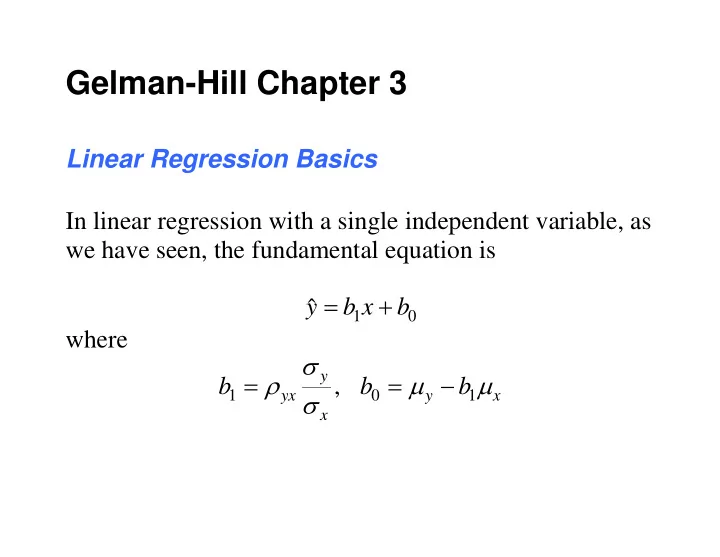

Gelman-Hill Chapter 3 Linear Regression Basics In linear regression with a single independent variable, as we have seen, the fundamental equation is ˆ y b x b 1 0 where y , b b b 1 0 1 yx y x x
Bivariate Normal Regression A key result is that if y and x have a bivariate normal distribution, then the conditional distribution of y given is normal, with mean , and standard x a b a b | 1 0 y x a 2 deviation 1 e xy y Note that the conditional mean is “on the regression line” relating y to x, and the conditional standard deviation is the same for all conditional values of x .
Preliminary Setup Set up a working directory for this lecture, and copy the Chapter 3 files to it. Switch to your working directory, using the Change dir command:
Then make sure you have installed the R package arm . If you are in the micro lab, you will need to tell R to install packages into a personal library directory, because the micro lab prohibits alteration of the basic R library space as a precaution against viruses. To do this, after you have switched to your working directory, create a personal library directory, and tell R to install packages in this directory. For example, create the directory c:/MyRLibs, then issue the R command > .libPaths(‘c:/MyRLibs’) R will now install new packages in this directory.
Next, install the arm package.
Kids Data Example G-H begin with a very simple regression in which one of the predictors is binary. We read in the data with the command > kidiq <- read.dta(file="kidiq.dta") This is actually a “data frame.” Let’s take a look with the editor. > edit(kidsiq)
We can access the objects in a data frame by using the $ character. For example, to compute the mean of the kid_score variable, we could say > mean(kidiq$kid_score) [1] 87 However, it is a lot easier to attach the data frame, after which we can simply refer to the variables by name. > attach(kidiq) > mean(kid_score) [1] 87
G-H have labels in their chapter that are slightly different from those in their data file. To maintain compatibility with the chapter, we create some new variables with these names. > kid.score <-kid_score > mom.hs <- mom_hs > mom.iq <- mom_iq Let’s look at a plot of kid.score versus the mom.hs variable. > plot(mom.hs, kid.score)
140 120 100 kid.score 80 60 40 20 0.0 0.2 0.4 0.6 0.8 1.0 mom.hs Not much of a plot, because mom.hs is binary. To fit a linear model to these variables, we use the lm command, and save the result in a fit object.
> fit.1 <- lm (kid.score ~ mom.hs) The model code kid.score ~ mom.hs is R code for kid.score mom.hs error b b 1 0 The intercept term is assumed, as is the error. Once we have the fit, we can examine the result in a variety of ways.
> display(fit.1) lm(formula = kid.score ~ mom.hs) coef.est coef.se (Intercept) 77.55 2.06 mom.hs 11.77 2.32 --- n = 434, k = 2 residual sd = 19.85, R-Squared = 0.06
> print(fit.1) Call: lm(formula = kid.score ~ mom.hs) Coefficients: (Intercept) mom.hs 77.5 11.8
> summary(fit.1) Call: lm(formula = kid.score ~ mom.hs) Residuals: Min 1Q Median 3Q Max -57.55 -13.32 2.68 14.68 58.45 Coefficients: Estimate Std. Error t value Pr(>|t|) (Intercept) 77.55 2.06 37.67 <2e-16 *** mom.hs 11.77 2.32 5.07 6e-07 *** --- Signif. codes: 0 ‘***’ 0.001 ‘**’ 0.01 ‘*’ 0.05 ‘.’ 0.1 ‘ ’ 1 Residual standard error: 20 on 432 degrees of freedom Multiple R-squared: 0.0561, Adjusted R-squared: 0.0539 F-statistic: 25.7 on 1 and 432 DF, p-value: 5.96e-07
Plotting the Regression plot (mom.hs, kid.score, xlab="Mother HS", ylab="Child test score") curve (coef(fit.1)[1] + coef(fit.1)[2]*x, add=TRUE) 140 120 100 Child test score 80 60 40 20 0.0 0.2 0.4 0.6 0.8 1.0 Mother HS
> ### two fitted regression lines > > ## model with no interaction > fit.3 <- lm (kid.score ~ mom.hs + mom.iq) > colors <- ifelse (mom.hs==1, "black", "gray") > plot (mom.iq, kid.score, xlab="Mother IQ score", ylab="Child test score", + col=colors, pch=20) > curve (cbind (1, 1, x) %*% coef(fit.3), add=TRUE, col="black") > curve (cbind (1, 0, x) %*% coef(fit.3), add=TRUE, col="gray") 140 120 100 Child test score 80 60 40 20 70 80 90 100 110 120 130 140 Mother IQ score
Interpretation of Coefficients > print(fit.3) Call: lm(formula = kid.score ~ mom.hs + mom.iq) Coefficients: (Intercept) mom.hs mom.iq 25.732 5.950 0.564 “Predictive” vs. “Counterfactual” Interpretation
> ### two fitted regression lines: > ## model with interaction > fit.4 <- lm (kid.score ~ mom.hs + mom.iq + mom.hs:mom.iq) > colors <- ifelse (mom.hs==1, "black", "gray") > plot (mom.iq, kid.score, xlab="Mother IQ score", ylab="Child test score", + col=colors, pch=20) > curve (cbind (1, 1, x, 1*x) %*% coef(fit.4), add=TRUE, col="black") > curve (cbind (1, 0, x, 0*x) %*% coef(fit.4), add=TRUE, col="gray") >print(fit.4) Call: lm(formula = kid.score ~ mom.hs + mom.iq + mom.hs:mom.iq) Coefficients: (Intercept) mom.hs mom.iq mom.hs:mom.iq -11.482 51.268 0.969 -0.484
140 130 120 Mother IQ score 110 100 90 80 70 140 120 100 80 60 40 20 Child test score
The overall equation is kid.score 51.3 mom.hs .969 mom.iq .484 mom.hs mom.iq 11.5 With mom.hs = 0, the equation becomes kid.score 11.5 .969 mom.iq With mom.hs = 1, the equation becomes kid.score 51.3 .969 mom.iq .484 mom.iq 11.5 39.8 .485 mom.iq We can see this better by extending the plot:
> plot (mom.iq, kid.score, xlab="Mother IQ score", ylab="Child test score",col=colors, pch=20,xlim=c(0,150),ylim=c(-15,150)) > curve (cbind (1, 1, x, 1*x) %*% coef(fit.4), add=TRUE, col="black") > curve (cbind (1, 0, x, 0*x) %*% coef(fit.4), add=TRUE, col="gray")
Recommend
More recommend